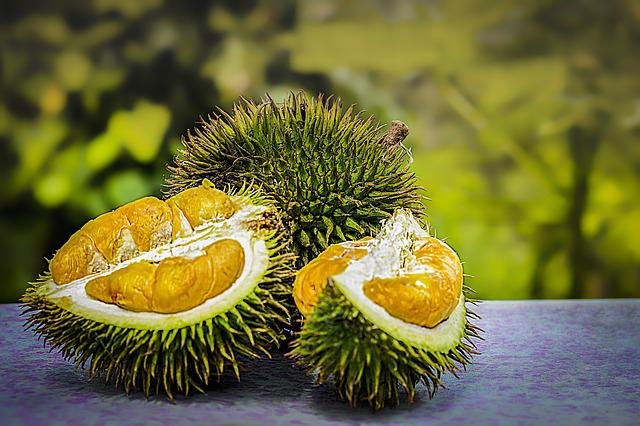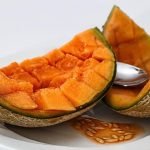
Although little known, durian has earned the nickname “king of fruits”. Let’s find out what it’s good for, how much to eat and where to find it.
Perhaps not everyone knows durian, a very particular exotic fruit from various points of view. It is the fruit of a plant typical of South East Asia, belonging to the Malvaceae family and there are several species. They are evergreen trees, very tall, usually between 20 and 40 meters, which produce a lot of fruit.
The first peculiarity of durian is its appearance: it has quite large dimensions, like those of a melon (or even more), and a thorny surface, which makes it difficult to handle.
What is immediately striking about this fruit, however, is its very strong and unpleasant smell, to the point of being prohibited in some hotels and in the subways of the countries where it grows spontaneously. Despite this first “contraindication”, it is very good and rich in beneficial properties for the body. In the countries where the plant grows (Indonesia, Malaysia, Thailand), durian is a very popular fruit.
Covered with sharp thorns, the thick durian skin hides a soft and creamy heart. The color can vary from white to pink (depending on the degree of ripeness), up to a reddish hue. Its width can reach 30 centimeters and can weigh up to 5 kilos. Despite the pungent smell, the pulp of ripe durian is sweet and has such a particular flavor that it cannot be described in words, as if it were a mix of tropical fruits.
Durian: calories and nutritional properties
Durian is a very nutritious fruit and rich in properties. 100 grams of this fruit provide 147 kcal, mainly in the form of carbohydrates and fiber. 65% of its weight is made up of water and about 5% of fat, but it does not contain cholesterol .
Its nutritional composition is distinguished by the high content of vitamins, including vitamin C, contained in large quantities, the B vitamins, and minerals, such as magnesium, potassium, phosphorus. An important feature of durian is also the important content of antioxidant agents that are beneficial for our health. We see below the table with the nutritional values of durian.
Nutritional values per 100g of banana:
- Kcal: 147
- Carbohydrates: 27.1 g
- Proteins: 1.47 g
- Fat: 5.33 g
- Waterfall: 65 g
- Fibers: 3.8 g
- Soccer: 6 mg
- Iron: 0.43 mg
- Magnesium: 30 mg
- Potassium: 436 mg
- Phosphorus: 39 mg
- Sodium: 2 mg
- Zinc: 0.28 mg
- Manganese: 0.32 mg
- C vitamin: 19.7 mg
- Thiamine: 0.374 mg
- Riboflavin: 0.2 mg
- Niacin: 1.07 mg
- Pantothenic: acid 0.23 mg
- Vitamin: B6 0.316 mg
- Folate: 36 mcg
- Beta carotene: 23 mcg
Durian: the health benefits
Durian is a fruit rich in macronutrients (in particular sugars and fats) and micronutrients (minerals, vitamins and bioactive compounds) which make it an exceptional food with various beneficial effects on our health. The anti-inflammatory and antioxidant compounds it contains work in synergy to counteract the onset of chronic inflammatory diseases affecting the cardiovascular system but also the nervous system, it also has antiproliferative and cholesterol-lowering effects and acts as a prebiotic. Let’s look at the properties of durian in detail and find out why eating durian is good for you.
✓ Antioxidant and anti-inflammatory
Durian contains numerous antioxidant compounds, such as polyphenols, flavonoids, tannins, carotenoids, capable of exercising a protective role against the onset of chronic inflammatory diseases such as Alzheimer’s, Parkinson’s, diabetes or cardiovascular diseases.
✓ Lowers cholesterol levels
Durian’s anti-atherosclerotic properties have been demonstrated in animal models. Furthermore, this food reduces plasma cholesterol levels, in particular bad cholesterol, probably by inhibiting its endogenous synthesis.
✓ Beneficial for the digestive system
Thanks to the fiber it contains, durian not only helps regulate the absorption of nutrients, but also facilitates the transit of fecal mass, contributing to the well-being of the intestine. The anti-inflammatory compounds also exert a protective action on the mucous membranes of the stomach and intestines.
✓ Ally of the cardiovascular system
Durian is a food particularly rich in folate, which makes it excellent for the cardiovascular system, so a correct intake of folate is essential to ensure its functions are at its best.
✓ Beneficial for the nervous system
The folates of which durian is rich are also essential for the nervous system, some studies show that these vitamins can have protective effects against neurodegenerative diseases such as Alzheimer’s.
✓ Regulates blood sugar
Durian is a fruit with a low glycemic index (equal to 49), especially when compared to that of other tropical fruits, probably thanks to the presence of fibers and fats. Eating durian has been found not to directly affect blood glucose levels, but it does affect glycemic response by slowing gastric emptying and thus lowering the rate of glucose absorption.
✓ Restorative
Not only does durian have an excellent composition in macronutrients, that is, in carbohydrates, proteins and good fats, but it also has a high content of mineral salts, such as potassium, which is comparable to that contained in bananas. It is therefore excellent as a tonic and replenishes the mineral salts lost after physical exertion.
✓ Useful in cancer prevention
This fruit contains numerous polyphenols, which in scientific literature are known for their antiproliferative effects, so durian could have an effect in the prevention of tumors.
✓ Prebiotic effects
Both the fibers and the sugars contained in durian constitute an excellent growth substrate for the bacterial flora, which we know to be fundamental not only for the well-being of the intestine, but also for the proper functioning of the immune system.
What does durian taste like?
If you can overcome the impact with the smell that the durian gives off, which, it must be admitted, is really unpleasant, it seems that in reality the taste is excellent, similar to that of a mix of various tropical fruits but with a spicy note and spicy and an aftertaste that is a mix of walnut, resin, onion, cheese, egg and with a slightly buttery texture. If eaten slightly unripe the taste and smell are less strong than those of the more mature fruit but of course it is advisable to eat it at the right degree of ripeness. Of course, for those not accustomed to these types of tastes, it might be “strange”, but the local people seem to literally love it.
Why does durian smell bad?
The bad smell, which many actually define “stink”, that durian gives off, is due to the richness of hydrogen sulphide and other sulfur-based compounds that this fruit contains, and which are the compounds at the base of many beneficial properties of durian. These are in fact volatile compounds that spread in the air very quickly and which are the ones that attribute to durian antioxidant and anti-inflammatory properties.
How much durian to eat
Durian is a fairly caloric fruit, so the recommended serving (even if you are on a diet and don’t want to risk overdoing calories) is about 50 grams. This will give you around 70 kcal, which is just fine for a light but nutritious snack. In these quantities it would also be possible to eat it every day, since, as we have seen, it is a fruit with exceptional nutritional properties.
How to open and eat durian
Even opening the durian could prove to be a small challenge: its skin is in fact thick and thorny, so it would not be a bad idea to put on protective gloves and arm yourself with a knife and patience. First of all, it will be necessary to cut the peel and cut lengthwise along one of the grooves and then open the fruit in half with the help of your hands.
At this point the pulp can be removed (divided into sections similar to very large beans) and proceed to tasting, which could be an unexpected and pleasant experience. Naturally it is possible to eat durian plain, but the populations of South East Asia enjoy it in many different preparations.
Typically accompanies rice. Probably, eating it in recipes along with other ingredients could mitigate its smell. From durian it is also obtained a jam with which it is possible to fill pies and shortbreads and also an excellent ice cream. It is also possible to add it to pastry doughs such as pancakes. It also lends itself to savory preparations as an accompaniment to meat or fish main courses. Often they make chips that are fried.
Durian vs jackfruit: the differences
Jackfruit, like durian, is also a typical fruit of South East Asia and is also very similar to durian in appearance, in fact it shares its size and wrinkled skin, but that of durian is covered with larger and more pointed spines. Its pulp is divided into more numerous and smaller clusters than those of durian, but of the same color tending to yellow. The taste and smell of the two fruits, however, are decidedly different: the jackfruit has a much more delicate and sweet taste and does not have the pungent smell of durian.
Also from the nutritional point of view the two fruits are decidedly different, because the nutritional values of the jackfruit are very close to those of other tropical fruits, having for example a higher water content than durian, a lower fat content and also a lower content. much lower caloric, equal to about 95 kcal per 100 grams.
Durian: the possible contraindications
The most obvious and immediate contraindication when it comes to durian is its pungent smell, which makes it even unsuitable for transport. In some places, it is forbidden to enter closed environments and means of transport.
Of course, an important contraindication is a specific allergy to some component of the fruit itself. Even in the case of diabetes, as we have seen, it can be consumed as it regulates blood sugar. Furthermore, as always, eating it in exaggerated quantities is always contraindicated, both to avoid gastrointestinal reactions and because, as we have seen, durian has a fairly high caloric content.
Durian: where to buy
In the production countries, of course, it is very easy to find the durian fruit, also and above all in the typical open-air markets. It could be a bit more complicated to find it, in fact if you wanted to taste it fresh you should rely on an ethnic food retailer, but usually on order because displaying durian in the store might not be a very good idea. Another alternative would be to order it online at specialized stores.
Obviously, we must expect to buy it at a price that is not exactly modest, also considering the transport difficulties, a price that seems to be around 50 USD per kg. If instead we wanted to be satisfied with tasting it frozen it would be easier to find it in ethnic food stores in packages in which we would find only the pulp, or, again in these shops you could find dehydrated durian chips. In these cases we would not enjoy the flavor of fresh durian, but waiting to be able to eat it directly in the place of production we could be satisfied!






